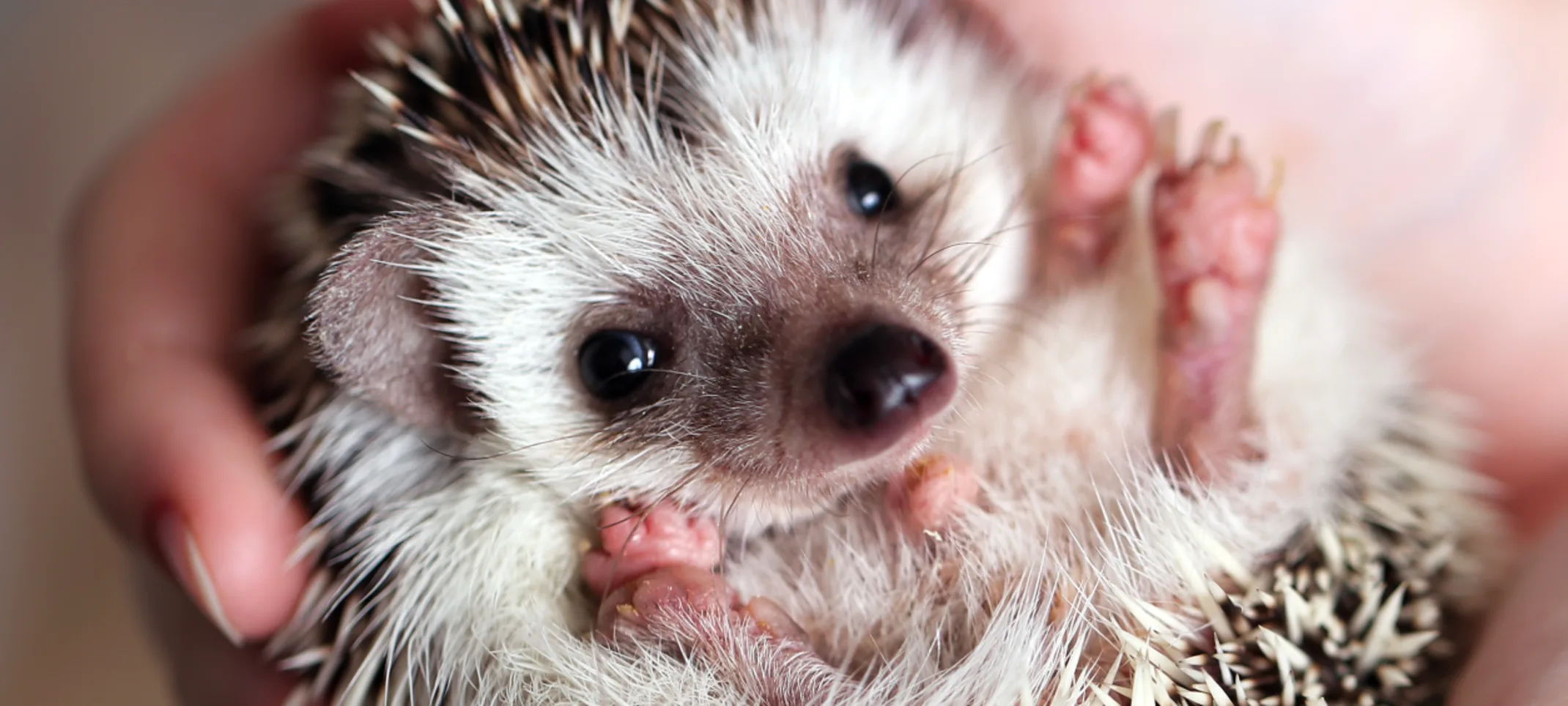I-20 Animal Medical Center
Hedgehog Husbandry
Hedgehogs are fascinating little creatures with highly developed senses of hearing and smell.

Hedgehogs are fascinating little creatures! They are insectivores (insect-eaters), which explains why they are most active at dawn and dusk. Hedgehogs have highly developed senses of hearing and smell, which aid them in locating their prey in the wild. Hedgehogs tend to be solitary animals, and do best when kept alone in an enclosure. Hedgehogs have long spines along their backs and sides, which give them protection from predators. They will hiss and roll into a ball, using the spines to deter predators and protecting their soft underbelly from attack. The spines are actually made of keratin, the same substance that makes up hair and fingernails. Males are normally larger than females, and weights range between 250-600 grams. Hedgehogs typically live on average 4-7 years.
Getting to Know Your Hedgehog
Hedgehogs take a lot of time and patience in order to become accustomed to being handled by people. They are not naturally inclined to enjoy handling, and are timid and nervous creatures. Choosing a young hedgehog will give you a better chance of being able to pick him up and handle him, because it is harder to get an adult hedgehog to tame down. In the beginning, it might be a good idea to give your hedgehog about a week to acclimate to his new surroundings. Sit by his cage, feed favorite treats, and keep handling to a minimum to avoid stress.
Once your hedgehog has settled in, begin gentle handling daily for small amounts at a time. Pick a room that is quiet with low lighting, and allow your hedgehog to sit on your hand. He may initially roll into a ball, but use gentle stroking of the spines (backwards stroking of the spines along the back and rump has been recommended) and a quiet tone of voice. Over time, your hedgehog should become accustomed to being handled, and the goal should be that your hedgehog does not feel threatened (hiss, roll into ball) when handled. Stressed hedgehogs will sometimes distribute their saliva over their body in a process called “anointing”. If you notice this happening during handling, handle for shorter periods of time until your hedgehog becomes more relaxed. Because of their timid nature, hedgehogs do not make good pets for young children.
Housing
Glass terrarium housing is appropriate for hedgehogs, and should be large enough with ample floor space to allow exercise and tall enough to prevent escape. Make sure the cage is well ventilated to avoid ammonia buildup. Wire mesh is not recommended for hedgehogs. Keep the cage in a warm room (75-85 degrees F) as hedgehogs tend to chill easily. Offer an exercise wheel with solid flooring (no open mesh or wire squares for toes to get caught in!) so that your hedgehog can exercise.
A hide box is essential for these shy creatures. Wood hide boxes, cardboard boxes, untreated fruit tree limbs or upturned flower pots are all good options for décor and hiding places for your hedgehog enclosure. A shallow pan with lukewarm or ambient temperature water can also be used for bathing and swimming.
Substrate
A recycled newspaper bedding (Carefresh or similar product) should be used as a substrate for your hedgehog. Make the bedding several inches thick as hedgehogs like to burrow. The bedding should be replaced at least weekly, and changed more often as needed. Avoid natural beddings such as pine, aspen, cedar, corncob, and wood chips/shavings as these can cause respiratory problems and dust allergies.
Nutrition
Hedgehogs do best on a diet of commercial hedgehog pellets, insects, and small amounts of vegetables, fruits and treats. Mealworms and crickets are the most common insects fed to hedgehogs. 3-5 insects can be fed 3-4 times weekly. Insects should be gut loaded (fed a commercial insect diet high in calcium and nutrients for several days prior to being fed to the hedgehog – think of insects that aren’t gut loaded as an empty shell, and by gut loading them, you are filling up the inside of that shell with good nutrition!).
Freeze-dried mealsworms are also sold and can be a good option if you don’t want to handle live insects, as long as your hedgehog will eat them. Freeze-dried mealworms have been gut loaded prior to freezing. 2-3 tbsp dry hedgehog diet should be offered daily, and a small salad of dark leafy greens, chopped vegetables, and sliced fruits can be offered as well. Feed at night; most of the food should be gone the following morning. If food is left over, you are probably feeding your hedgehog too much. Avoid fatty treats and foods, as hedgehogs tend to become overweight quite easily!
Medical Care
New pet hedgehogs should be examined within the first week to look for any signs of illness and intestinal parasites. Bring your hedgehog in a carrier or travel cage for safety. Exams should then be performed once a year to make sure your hedgehog is healthy. Knowing the common diseases in hedgehogs and what signs to look for will help you know if you need to bring your hedgehog in for an exam.
With exotic pets, they tend to hide signs of illness until they can no longer possibly maintain the appearance of being normal. This is because they are prey animals, and their instincts tell them that to survive they must look happy and healthy or they will be targeted by predators. Unfortunately for us, this means that usually when we first notice our pet hedgehogs are sick, they have actually been sick for days if not weeks. You usually don’t have the luxury of a “wait and see” approach to see if your hedgehog is going to get better without treatment. Early medical care is vital to helping your hedgehog!
Here are some common diseases in hedgehogs and what signs to watch for in your pets:
Mites
Mites are common in hedgehogs, and affect the spines. Hedgehogs with mites are typically very itchy, and there will be loss or blunting of the spines. Mites can be easily treated once diagnosed.
Obesity
Hedgehogs love to eat, and they don’t always want to eat the healthy foods! You can tell if your hedgehog is overweight by watching him roll into a ball – if he can’t make it all the way into a tight ball, then it’s diet time! Obesity can lead to many different health problems, like joint disease, cardiac disease, and respiratory disease.
Dental disease
Hedgehogs have many little teeth, and these teeth can become diseased over time. Dental cleanings and extractions may be recommended at some point in your hedgehog’s life to keep him healthy.
Pneumonia
Respiratory infections are common in hedgehogs kept on natural beddings and not on Carefresh or a similar recycled newspaper product. Lung worms can also be an underlying cause of respiratory problems.
Cancer
As hedgehogs age, they are prone to developing tumors. These can sometimes be benign, but some are malignant. Surgery is the preferred treatment. Even if tumors are benign, sometimes they can grow so large that they cause problems with mobility or breathing, or they can become ulcerated and infected.
A minimum of a 30 day quarantine period is recommended for any new pet being brought into a home with existing exotic pets. This is to protect the owner’s previous pets from any new diseases or parasites a new pet could be carrying. Most infectious diseases will have symptoms show up within that 30 day period. Quarantined pets should be kept in a separate room if possible, and have separate food and water bowls throughout the quarantine period. Handle your previous pets first, then handle your new pet last. After the quarantine period is over, and your new pet has shown no signs of illness and has seen a veterinarian, your previous pets should be safe from most communicable diseases.
